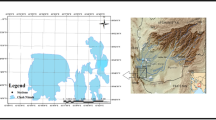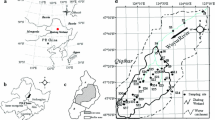Abstract
Health of birds and heavy metal toxicity are growing concerns in Pakistan because of irresponsible industrial waste management and farming practices. Eight species of common wild birds were studied from three different study sites which varied in the type of environmental pollution (Kasur: industrial waste, Lahore city: traffic pollution and Shahdara: mixed pollution of traffic, sewerage, and industry which the Ravi River accumulates). Heavy metal analysis of six heavy metals in the various organs of birds showed that there was no evidence of organ preference for metal accumulation in birds. Shahdara and Kasur with numerous industries both showed chromium concentrations above toxicity levels in 54.16% tissues of Granivorous birds, 60% of omnivorous birds, and 33.33% in tissues of carnivorous species. Statistical analysis proved that there is no correlation between weight of birds and accumulation of metals; it depends on food preference of birds and properties of the metals as bioaccumulators or biomagnifiers.









Similar content being viewed by others
Data availability
The data generated and analyzed for this research is available from the corresponding author whenever required.
References
Ali, H., & Khan, E. (2019). Trophic transfer, bioaccumulation, and biomagnification of non-essential hazardous heavy metals and metalloids in food chains/webs—Concepts and implications for wildlife and human health. Human and Ecological Risk Assessment: an International Journal, 25(6), 1353–1376. https://doi.org/10.1080/10807039.2018.1469398
Alloway, B. J. (2012). Sources of heavy metals and metalloids in soils environmental pollution. EPOL, 22, 11–50.
Boncompagni, E., Muhammad, A., Jabeen, R., Orvini, E., Gandini, C., Sanpera, C., & Fasola, M. (2003). Egrets as monitors of trace-metal contamination in wetlands of Pakistan. Archives of Environmental Contamination and Toxicology, 45, 399–406. https://doi.org/10.1007/s00244-003-0198-y
Bostan, N., Ashraf, M., Mumtaz, A. S., & Ahmad, I. (2007). Diagnosis of heavy metal contamination in agro-ecology of Gujranwala, Pakistan using cattle egret (Bubulcus Ibis) as bioindicator. Ecotoxicology, 16(2), 247–251. https://doi.org/10.1007/s10646-006-0124-y
Dauwe, T., Bervoets, L., Pinxten, R., Blust, R., & Eens, M. (2003). Variation of heavy metals within and among feathers of birds of prey: Effects of molt and external contamination. Environmental Pollution, 124(3), 429–436. https://doi.org/10.1016/S0269-7491(03)00044-7
Gilbert, M., Oaks, J. L., Virani, M. Z., Watson, R. T., Ahmed, S., Chaudhry, M. J. I., ... & Khan, A. A. (2004). The status and decline of vultures in the provinces of Punjab and Sind, Pakistan: A 2003 update. Raptors worldwide (Eds: Chancellor, RC & BU Meyburg). World Working Group on Birds of Prey/MME-BirdLife Hungary, 221–234.
Haider, H., & Ali, W. (2013). Evaluation of water quality management alternatives to control dissolved oxygen and un-ionized ammonia for Ravi River in Pakistan. Environmental Modeling & Assessment, 18, 451–469. https://doi.org/10.1007/s10666-012-9353-z
Hashmi, M. Z., Malik, R. N., & Shahbaz, M. (2013). Heavy metals in eggshells of cattle (Bubulcus ibis) and little egret (Egretta garzetta) from the Punjab province, Pakistan. Ecotoxicology and Environmental Safety, 89, 158–165. https://doi.org/10.1016/j.ecoenv.2012.11.029
Kim, J., Shin, J. R., & Koo, T. H. (2008). Heavy metal distribution in some wild birds from Korea. Archives of Environmental Contamination and Toxicology, 56, 317–324. https://doi.org/10.1007/s00244-008-9180-z
Joutey, N. T., Sayel, H., Bahafid, W., & El Ghachtouli, N. (2015). Mechanisms of hexavalent chromium resistance and removal by microorganisms. Reviews of Environmental Contamination and Toxicology., 233, 45–69. https://doi.org/10.1007/978-3-319-10479-9_2
Kumar, V., Parihar, R. D., Sharma, A., Bakshi, P., Sidhu, G. P. S., Bali, A. S., Karaouzas, I., Bhardwaj, R., Thukral, A. K., & Gyasi-Agyei, Y. (2019a). Global evaluation of heavy metal content in surface water bodies: A meta-analysis using heavy metal pollution indices and multivariate statistical analyses. Chemosphere, 236, 124364. https://doi.org/10.1016/j.chemosphere.2019.124364
Kumar, V., Sharma, A., Kaur, P., Sidhu, G. P. S., Bali, A. S., Bhardwaj, R., Thukral, A. K., & Cerda, A. (2019b). Pollution assessment of heavy metals in soils of India and ecological risk assessment: A state-of-the-art. Chemosphere, 216, 449–462. https://doi.org/10.1016/j.chemosphere.2018.10.066
KaleemUllah, K., Hashmi, M. Z., & MalikR, N. (2013). Heavy-metal levels in feathers of cattle egret and their surrounding environment: A case of the Punjab Province. Archives of Environmental Contamination and Toxicology. https://doi.org/10.1007/s00244-013-9939-8
Lü, Y., Gong, Q.-Q., & Li, Z.-Q. (2008). Heavy metal contents in organs of sparrow in Mudanjiang. Journal of Ecology and Rural Environment, 24(3), 94–96.
Outridge, P. M., & Scheuhammer, A. M. (1993). Rev Bioaccumulation and toxicology of chromium: Implications for wildlife. Reviews of Environmental Contamination and Toxicology, 130, 31–77. https://doi.org/10.1007/978-1-4613-9763-2_2
Williams, D. M. (1983, April). Copper deficiency in humans. In Seminars in Hematology, 20(2), 118–128.
Wuana, R. A., & Okieimen, F. E. (2011). Heavy Metals in contaminated soils: A review of sources, chemistry, risks and best available strategies for remediation. International Scholarly Research Notices, 2011. https://doi.org/10.5402/2011/402647
Raza, H., Mehmood, S., Khan, B. N., & Bibi, F. (2015). Avian diversity of lahore zoo safari in winter season Lahore, Pakistan. Journal of Animal & Plant Sciences, 25(3), 378–381.
Shahbaz, M., Hashmi, M. Z., Malik, R. N., & Yasmin, A. (2013). Relationship between heavy metals concentrations in egret species, their environment and food chain differences from two Headworks of Pakistan. Chemosphere, 93(2), 274–282. https://doi.org/10.1016/j.chemosphere.2013.04.078
Liu, X. F., Li, Z. P., Tie, F., Liu, N., Zhang, Z. W., & Xu, S. W. (2013). Effects of manganese-toxicity on immune-related organs of cocks. Chemosphere, 90(7), 2085–2100. https://doi.org/10.1016/j.chemosphere.2012.10.072
Yaqoob, Z., Shams, S. B., Joshua, G., & Murtaza, B. N. (2020). Bioaccumulation of metals in the organs of fish inhabiting Ravi River: Serious threat to fish and consumer’s health. Pakistan Journal of Zoology, 52(6), 2027–2037. https://doi.org/10.17582/journal.pjz/20180505000547
Zhou, Z., Barrett, P. M., & Hilton, J. (2003). An exceptionally preserved Lower Cretaceous ecosystem. Nature, 421, 807–814. https://doi.org/10.1038/nature01420
Acknowledgements
Gratitude is extended to the Punjab Wild Life Department for facilitating us in this study, especially Mr. Ghulam Rasool Awan, Mr. Tanveer Janjua, Mr. Abdul Shakoor Manj, Syed Ali Usman Bukhari, Mr. Khuwaja Junaid, and Mian Rafiq.
Author information
Authors and Affiliations
Contributions
Gaitee Joshua: design, performance of tests, interpretation and analysis of data. Zulfiqar Ali: design and supervision. Mehak Ayub: performance of tests. Shamaila Inayat: performance of tests. All the authors approved the data for publication.
Corresponding author
Ethics declarations
Ethical approval
The research was approved by the Ethical Committee, The Doctoral Programme Coordination Committee (DPCC) and the Advanced Studies and Research Board (ASRB) of the University of Punjab.
Additional information
Publisher's Note
Springer Nature remains neutral with regard to jurisdictional claims in published maps and institutional affiliations.
Rights and permissions
About this article
Cite this article
Joshua, G., Ali, Z., Ayub, M. et al. Heavy metal contamination in wild avian species inhabiting human-modified habitats. Environ Monit Assess 193, 588 (2021). https://doi.org/10.1007/s10661-021-09387-2
Received:
Accepted:
Published:
DOI: https://doi.org/10.1007/s10661-021-09387-2




